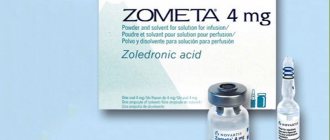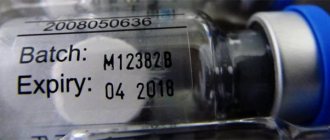Gemzar
Active substance:
Gemcitabine*
Pharmgroup:
Antimetabolites
Analogs for the active substance:Gemita Gemceks Gemcitabine Gemcitabine medac Gemcitabine Pliva Gemcitabine hydrochloride Gemcytar Gemcitera Gemcytover Ongetsin Cytogem | Application area:Adenocarcinoma of the prostate Ovarian adenocarcinoma pseudomucinous Adenomyosarcoma Adenomyocystosarcoma Adenosarcoma of the kidney Wilms tumor Wilms tumor Germ cell tumor of the ovary Germ cell tumor of the ovaries Hormone-dependent form of recurrent breast cancer in menopausal women Hormone-dependent breast cancer Hormone-dependent prostate cancer Hormone-resistant prostate cancer Disseminated breast carcinoma Disseminated breast cancer Disseminated breast cancer with HER2 overexpression Malignant breast tumor Malignant tumor of the bladder Malignant prostate tumor Malignant ovarian tumor Malignant neoplasm of the breast Malignant neoplasm of the prostate Malignant neoplasms of the bladder Breast carcinoma Bladder carcinoma Prostate carcinoma Mucinous ovarian carcinoma Ovarian carcinoma Contralateral breast cancer Locally advanced or metastatic breast cancer Locally advanced non-metastatic prostate cancer Locally advanced breast cancer Locally advanced prostate cancer Locally recurrent breast cancer Locally advanced prostate cancer Metastatic malignant tumor of the ovaries Metastatic breast carcinoma Metastatic prostate carcinoma Metastatic ovarian carcinoma Metastatic prostate cancer Metastases of breast tumors Metastatic breast carcinoma Metastatic renal cell carcinoma Metastatic kidney carcinomas Metastatic hormone-resistant prostate cancer Metastatic renal cell carcinoma Metastatic bladder cancer Metastatic ovarian cancer Metastatic ovarian cancer Non-metastatic prostate cancer Inoperable breast carcinoma Inoperable kidney carcinomas Inoperable breast cancer Inoperable prostate cancer Nephroblastoma Nephroma Embryonic nephroma Breast tumors Bladder tumors Kidney tumors Birch-Hirschfeld tumor Wilms tumor Bladder tumor Ovarian tumor Transitional cell carcinoma of the bladder Renal carcinoma Breast cancer in women with metastases Breast cancer in men with metastases Breast cancer Breast cancer in men Cancer from pseudomucinous cyst Mammary cancer Breast cancer with distant metastases Postmenopausal breast cancer Breast cancer is hormone dependent Breast cancer with local metastases Breast cancer with metastases Breast cancer with regional metastases Breast cancer with metastases Bladder cancer Superficial bladder cancer Kidney cancer Kidney cancer Prostate cancer Prostate cancer Nipple and areola cancer Ovarian cancer Ovarian cancer Advanced renal cell carcinoma Common hormone-dependent forms of breast cancer Advanced metastatic ovarian cancer Advanced renal cell carcinoma Advanced breast cancer Advanced prostate cancer Advanced ovarian cancer |
Gemzar®
Gemcitabine is administered intravenously over 30 minutes.
Before each administration of gemcitabine, it is necessary to monitor the number of platelets, leukocytes and granulocytes in the blood. If there are signs of bone marrow suppression caused by the drug, it is necessary to suspend treatment or adjust the dose.
Non-small cell lung cancer (locally advanced or metastatic), first line of therapy.
Monotherapy:
The recommended dose of the drug is 1000 mg/m2 on days 1, 8, and 15 of each 28-day cycle.
Combination therapy with cisplatin:
The recommended dose of the drug is 1250 mg/m2 on days 1 and 8 of each 21-day cycle or 1000 mg/m2 on days 1, 8 and 15 of each 28-day cycle. Cisplatin is administered at a dose of 70 mg/m2 on day 1 of the cycle after gemcitabine infusion against the background of hyperhydration.
Combination therapy with carboplatin:
The recommended dose of the drug is 1000 mg/m2 or 1200 mg/m2 on days 1 and 8 of each 21-day cycle. Carboplatin is administered at an AUC (area under the concentration-time curve) of 5.0 mg/ml/min on day 1 of the cycle after gemcitabine infusion.
Breast cancer (unresectable, locally recurrent or metastatic). Combination therapy with paclitaxel:
As first-line therapy for disease progression after neoadjuvant and/or adjuvant therapy, including anthracyclines, in the absence of contraindications to them. Paclitaxel is administered at a dose of 175 mg/m2 intravenously over 3 hours on day 1 of a 21-day cycle, followed by gemcitabine. The recommended dose of the drug is 1250 mg/m2 on days 1 and 8 of each 21-day cycle. Before starting combination therapy (gemcitabine + paclitaxel), the absolute number of granulocytes in the blood of patients should be at least 1500/μl.
Urothelial cancer (bladder cancer (locally advanced, metastatic and superficial), renal pelvis, ureter, urethra).
Monotherapy:
The recommended dose of the drug is 1250 mg/m2 on days 1, 8 and 15 of each 28-day cycle.
Combination therapy with cisplatin:
The recommended dose of the drug is 1000 mg/m2 on days 1, 8 and 15 in combination with cisplatin, which is administered at a dose of 70 mg/m2 immediately after gemcitabine infusion on days 1 or 2 of each 28-day cycle. Clinical studies have shown that with a dose of cisplatin of 100 mg/m2, more pronounced myelosuppression is observed.
Epithelial ovarian cancer (locally advanced or metastatic, resistant to platinum derivatives).
Monotherapy:
The recommended dose of the drug is 800-1250 mg/m2 on days 1, 8 and 15 of each 28-day cycle. Combination therapy with carboplatin:
The recommended dose of the drug is 1000 mg/m2, on days 1 and 8, in combination with carboplatin at an AUC of 4.0 mg/ml/min, which is administered immediately after gemcitabine infusion on day 1 of each 21-day cycle.
Pancreatic cancer (locally advanced or metastatic, including resistant to fluorouracil therapy).
Monotherapy:
The recommended dose of the drug is 1000 mg/m2 once a week for 7 weeks, followed by a one-week break. The drug is then administered on days 1, 8 and 15 of each 28-day cycle.
Cervical cancer (locally advanced or metastatic).
Combination therapy with cisplatin:
For locally advanced cancer with sequential chemoradiation therapy (neoadjuvant) and for metastatic cancer, cisplatin is administered at a dose of 70 mg/m2 on day 1 of the cycle against the background of hyperhydration, followed by gemcitabine. Gemcitabine is administered at a dose of 1250 mg/m2 on days 1 and 8 of each 21-day cycle.
For locally advanced cancer with concurrent chemoradiation, cisplatin is administered at a dose followed (immediately after administration of cisplatin) by administration of gemcitabine. Gemcitabine is administered once a week 1-2 hours before the start of radiation therapy at a dose of 125 mg/m2.
Biliary tract cancer
Combination therapy with cisplatin:
Cisplatin is administered at a dose of 70 mg/m2 on day 1 of the cycle against the background of hyperhydration, followed by the administration of gemcitabine. Gemcitabine is administered at a dose of 1250 mg/m2 on days 1 and 8 of each 21-day cycle.
Dose adjustment
In case of hematological toxicity development
The dose of gemcitabine may be reduced or its administration delayed according to the following regimens:
A. Cycle dose adjustment of gemcitabine for urothelial cancer, non-small cell lung cancer, pancreatic cancer as monotherapy or in combination with cisplatin. Gemcitabine dose adjustment within a cycle for urothelial cancer, non-small cell lung cancer, pancreatic cancer as monotherapy or in combination with cisplatin
| Absolute granulocyte count (x 109/l) | Platelet count (x 109/L) | % of previous dose | |
| >1 | And | >100 | 100 |
| 0,5-1 | or | 50-100 | 75 |
| <0,5 | or | < 50 | Postpone administration |
B. Intra-cycle dose adjustment of gemcitabine for breast cancer in combination with paclitaxel.
Intra-cycle dose adjustment of gemcitabine for breast cancer in combination with paclitaxel
| Absolute granulocyte count (x 109/l) | Platelet count (x 109/L) | % of previous dose | |
| ≥1,2 | And | >75 | 100 |
| 1-<1,2 | or | 50-75 | 75 |
| 0,7-<1 | or | ≥50 | Postpone administration |
B. Intra-cycle dose adjustment of gemcitabine for ovarian cancer in combination with carboplatin.
Intra-cycle dose adjustment of gemcitabine for ovarian cancer in combination with carboplatin
| Absolute granulocyte count (x 109/l) | Platelet count (x 109/L) | % of previous dose | |
| >1,5 | And | ≥100 | 100 |
| 1-1,5 | or | 75-100 | 50 |
| <1 | or | <75 | Postpone administration |
To detect non-hematological toxicity, it is necessary to regularly evaluate the patient and monitor liver and kidney function. Depending on the degree of toxicity, the dose can be reduced during each cycle or at the start of a new cycle in steps.
Administration of the drug should be delayed until, in the judgment of the physician, toxicity has resolved.
Special patient groups
Elderly patients:
There are no data to suggest that dosage adjustments are necessary in elderly patients.
Patients with impaired liver and kidney function:
Gemcitabine should be used with caution in patients with liver failure or impaired renal function, since there is no sufficient data on the use of the drug in this category of patients. Mild or moderate renal failure (glomerular filtration rate from 30 ml/min to 80 ml/min ) has no significant effect on the pharmacokinetics of gemcitabine.
Children:
Gemcitabine has been studied in limited phase I and II studies in children with various types of neoplasms. Data from these studies are insufficient to demonstrate the effectiveness and safety of gemcitabine in children.
Recommendations for preparing solution for infusion
Only 0.9% sodium chloride solution without preservatives is used as a solvent.
To prepare a solution for infusion, the contents of a 200 mg bottle are dissolved in no less than 5 ml, and 1 g in no less than 25 ml of 0.9% sodium chloride solution for injection. Each bottle is gently shaken until the lyophilisate is completely dissolved. The resulting solution should be transparent.
The maximum concentration of gemcitabine should not exceed 40 mg/ml. Solutions prepared with concentrations higher than 40 mg/ml may be accompanied by incomplete dissolution. The prepared solution of gemcitabine, containing the required dose of the drug, is diluted with 0.9% sodium chloride solution for injection before administration in an amount sufficient for a 30-minute intravenous infusion.
Before parenteral administration, it is necessary to visually monitor the prepared solution for the presence of mechanical impurities and color changes.
Instructions:
pharmachologic effect
Pharmacological action - antitumor, cytostatic.
Contraindications
Hypersensitivity, pregnancy, breastfeeding.
Use during pregnancy and breastfeeding
Contraindicated during pregnancy.
FDA category of effect on the fetus is D.
Breastfeeding should be stopped during treatment.
Side effects of the drug
From the nervous system and sensory organs: headache, drowsiness, insomnia.
From the cardiovascular system and blood (hematopoiesis, hemostasis): myelosuppression (anemia, leukopenia, thrombocytopenia), decreased blood pressure, arrhythmia, heart failure, myocardial infarction, bleeding (occurred mainly in patients with pancreatic cancer).
From the respiratory system: bronchospastic reactions (shortness of breath, difficulty breathing, chest tightness and/or stertorous breathing), toxic effects on the lung parenchyma or pneumonitis (cough, shortness of breath), pulmonary edema (cough, difficulty breathing).
From the gastrointestinal tract: nausea, vomiting (69% of cases), diarrhea (19%), constipation, stomatitis (≤11%), increased activity of liver transaminases and alkaline phosphatase.
From the genitourinary system: proteinuria, hematuria, peripheral edema (fingers, toes or ankles); in rare cases, edema can be generalized; rarely - renal failure, hemolytic-uremic syndrome (decreased hemoglobin, thrombocytopenia, hyperbilirubinemia, hypercreatinemia, increased LDH activity and urea concentration).
From the skin: rash (30%), alopecia (usually minor), skin rashes, itching.
Other: often (41%) - flu-like syndrome (fever, headache, back pain, chills, myalgia, weakness, anorexia, catarrhal symptoms, sweating), infection (16%), less often - paresthesia, extravasate formation (irritation, pain or redness) at the injection site, drowsiness, rarely - Gasser's disease (black tarry stools, blood in the urine or stool, increased body temperature, increased or decreased urination, pinpoint red spots on the skin, swelling of the face, fingers, toes or ankles, unusual bleeding or bruising, unusual tiredness or weakness, yellowing of the sclera or skin).
Precautionary measures
The use of gemcitabine should be carried out under strict monitoring of blood counts (once every 2 weeks). If the number of leukocytes decreases <1500/mm3 and platelets <100,000/mm3, dose adjustment is required. The indication for discontinuation of the drug is a decrease in the number of leukocytes <500/mm3 and platelets <50,000/mm3.
If gemcitabine-induced pneumonitis is confirmed or suspected, treatment should be discontinued immediately.
Women of childbearing potential should use effective contraception (possible teratogenicity).
Use with caution in elderly people (increased risk of toxic effects on the blood), in patients who have previously received cytotoxic drugs or radiation therapy. You should refrain from potentially dangerous activities that require increased attention and speed of mental and motor reactions.
During the treatment period, vaccination with viral vaccines is not recommended. Prescription of viral vaccines is possible no earlier than 3 months - 1 year after stopping the use of the drug. Immunization with oral polio vaccine should be delayed in people who are close contacts of the patient, especially family members.
Signs of bone marrow suppression, unusual bleeding or hemorrhage, black tarry stools, blood in the urine or stool, or pinpoint red spots on the skin require immediate medical consultation.
Dental interventions must be completed before starting therapy or postponed until the blood picture normalizes. During treatment, be careful when using toothbrushes, floss or toothpicks.
When gemcitabine is used more than once per week or when the infusion is administered over more than 60 minutes, adverse effects associated with gemcitabine therapy may occur more frequently and be more severe.
Previous treatment with cytostatics increases the incidence and severity of leukopenia and thrombocytopenia (a progressive decrease in the number of leukocytes and platelets may occur after completion of therapy).
The use of gemcitabine should be carried out by specially trained medical personnel, observing established precautions when preparing, diluting injection solutions (in a sterile box using disposable surgical gloves and masks) and destroying needles, syringes, vials, ampoules and the remainder of the unused drug.
If gemcitabine accidentally comes into contact with the skin or mucous membranes, the affected area should be immediately washed with soap and water or thoroughly with a strong stream of water, respectively.
Storage conditions of the drug
List B.: At a temperature of 15–30 °C. Do not freeze.
Gemzar, 200 mg, lyophilisate for solution for infusion, 10 ml, 1 pc.
Gemcitabine is administered intravenously over 30 minutes.
Before each administration of gemcitabine, it is necessary to monitor the number of platelets, leukocytes and granulocytes in the blood. If there are signs of bone marrow suppression caused by the drug, it is necessary to suspend treatment or adjust the dose.
Non-small cell lung cancer
(locally advanced or metastatic), first line of therapy.
Monotherapy: The recommended dose of the drug is 1000 mg/m2 on days 1, 8, and 15 of each 28-day cycle.
Combination therapy with cisplatin: The recommended dose of the drug is 1250 mg/m2 on days 1 and 8 of each 21-day cycle or 1000 mg/m2 on days 1, 8 and 15 of each 28-day cycle. Cisplatin is administered at a dose of 70 mg/m2 on day 1 of the cycle after gemcitabine infusion against the background of hyperhydration.
Combination therapy with carboplatin: The recommended dose of the drug is 1000 mg/m2 or 1200 mg/m2 on days 1 and 8 of each 21-day cycle.
Carboplatin is administered at an AUC (area under the concentration-time curve) of 5.0 mg/ml/min on day 1 of the cycle after gemcitabine infusion.
Mammary cancer
(unresectable, locally recurrent or metastatic).
Combination therapy with paclitaxel: As first-line therapy for disease progression after neoadjuvant and/or adjuvant therapy including anthracyclines, in the absence of contraindications to them. Paclitaxel is administered at a dose of 175 mg/m2 intravenously over 3 hours on day 1 of a 21-day cycle, followed by gemcitabine. The recommended dose of the drug is 1250 mg/m2 on days 1 and 8 of each 21-day cycle.
Before starting combination therapy (gemcitabine + paclitaxel), the absolute number of granulocytes in the blood of patients should be at least 1500/μl.
Urothelial cancer
(cancer of the bladder (locally advanced, metastatic and superficial), renal pelvis, ureter, urethra).
Monotherapy: The recommended dose of the drug is 1250 mg/m2 on days 1, 8 and 15 of each 28-day cycle.
Combination therapy with cisplatin: The recommended dose of the drug is 1000 mg/m2 on days 1, 8 and 15 in combination with cisplatin, which is administered at a dose of 70 mg/m2 immediately after gemcitabine infusion on days 1 or 2 of each 28-day cycle. Clinical studies have shown that with a dose of cisplatin of 100 mg/m2, more pronounced myelosuppression is observed.
Epithelial ovarian cancer
(locally advanced or metastatic, resistant to platinum derivatives).
Monotherapy: The recommended dose of the drug is 800–1250 mg/m2 on days 1, 8 and 15 of each 28-day cycle.
Combination therapy with carboplatin: The recommended dose of the drug is 1000 mg/m2, on days 1 and 8 in combination with carboplatin at an AUC of 4.0 mg/ml/min, which is administered immediately after gemcitabine infusion on day 1 of each 21-day cycle.
Pancreas cancer
(locally advanced or metastatic, including resistant to fluorouracil therapy).
Monotherapy: The recommended dose of the drug is 1000 mg/m2 once a week for 7 weeks, followed by a one-week break. The drug is then administered on days 1, 8 and 15 of each 28-day cycle.
Cervical cancer
(locally advanced or metastatic).
Combination therapy with cisplatin: For locally advanced cancer with sequential chemoradiotherapy (neoadjuvant) and for metastatic cancer, cisplatin is administered at a dose of 70 mg/m2 on day 1 of the cycle against the background of hyperhydration, followed by gemcitabine. Gemcitabine is administered at a dose of 1250 mg/m2 on days 1 and 8 of each 21-day cycle.
For locally advanced cancer with simultaneous chemoradiotherapy, cisplatin is administered at a dose of 40 mg/m2 followed (immediately after the administration of cisplatin) by the administration of gemcitabine. Gemcitabine is administered once a week 1–2 hours before the start of radiation therapy at a dose of 125 mg/m2.
Biliary tract cancer
Combination therapy with cisplatin: Cisplatin is administered at a dose of 70 mg/m2 on day 1 of the cycle against the background of hyperhydration, followed by the administration of gemcitabine. Gemcitabine is administered at a dose of 1250 mg/m2 on days 1 and 8 of each 21-day cycle.
Dose adjustment
If hematologic toxicity occurs, the dose of gemcitabine may be reduced or its administration delayed according to the following regimens:
A. Dose adjustment of gemcitabine within a cycle for urothelial cancer, non-small cell lung cancer, pancreatic cancer as monotherapy or in combination with cisplatin.
| Gemcitabine dose adjustment within a cycle for urothelial cancer, non-small cell lung cancer, pancreatic cancer as monotherapy or in combination with cisplatin | |||
| Absolute granulocyte count (×109/l) | Platelet count (×109/l) | % of previous dose | |
| >1 | And | >100 | 100 |
| 0,5–1 | or | 50–100 | 75 |
| <0,5 | or | <50 | Postpone administration |
B. Intra-cycle dose adjustment of gemcitabine for breast cancer in combination with paclitaxel.
| Gemcitabine dose adjustment within a cycle for breast cancer in combination with paclitaxel | |||
| Absolute granulocyte count (×109/l) | Platelet count (×109/l) | % of previous dose | |
| ≥1,2 | And | >75 | 100 |
| 1–<1,2 | or | 50–75 | 75 |
| 0,7–<1 | And | ≥50 | 50 |
| <0,7 | or | <50 | Postpone administration |
B. Intra-cycle dose adjustment of gemcitabine for ovarian cancer in combination with carboplatin.
| Gemcitabine dose adjustment within a cycle for ovarian cancer in combination with carboplatin | |||
| Absolute granulocyte count (×109/l) | Platelet count (×109/l) | % of previous dose | |
| >1,5 | And | ≥100 | 100 |
| 1–1,5 | or | 75–100 | 50 |
| <1 | or | <75 | Postpone administration |
To detect non-hematological toxicity, it is necessary to regularly evaluate the patient and monitor liver and kidney function. Depending on the degree of toxicity, the dose can be reduced during each cycle or at the start of a new cycle in steps.
Administration of the drug should be delayed until, in the judgment of the physician, toxicity has resolved.
Special patient groups
Elderly patients:
There are no data to suggest that dosage adjustments are necessary in elderly patients.
Patients with impaired liver and kidney function:
Gemcitabine should be used with caution in patients with liver failure or impaired renal function, since there is no sufficient data on the use of the drug in this category of patients.
Mild or moderate renal impairment (glomerular filtration rate from 30 ml/min to 80 ml/min) does not have a significant effect on the pharmacokinetics of gemcitabine.
Children:
Gemcitabine has been studied in limited phase I and II studies in children with various types of neoplasms. Data from these studies are insufficient to demonstrate the effectiveness and safety of gemcitabine in children.
Recommendations for preparing solution for infusion
Only 0.9% sodium chloride solution without preservatives is used as a solvent.
To prepare the concentrate, the contents of a 200 mg bottle are dissolved in no less than 5 ml, and 1 g in no less than 25 ml of 0.9% sodium chloride solution for injection. Each bottle is gently shaken until the lyophilisate is completely dissolved. The resulting solution should be transparent.
The maximum concentration of gemcitabine should not exceed 40 mg/ml. Solutions prepared with concentrations higher than 40 mg/ml may be accompanied by incomplete dissolution.
The prepared gemcitabine concentrate containing the required dose of the drug is diluted before administration with 0.9% sodium chloride solution for injection in an amount sufficient for a 30-minute intravenous infusion.
Before parenteral administration, it is necessary to visually monitor the prepared solution for the presence of mechanical impurities and color changes.







